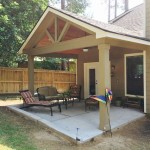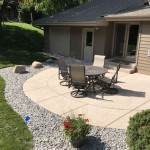```html
Outdoor Flagstone Patio Ideas For Beginners in Atlanta
Creating an outdoor flagstone patio can significantly enhance the aesthetic appeal and functionality of a residential property. Flagstone, a natural sedimentary rock, offers a unique combination of durability, visual interest, and versatility, making it a popular choice for patio construction. In Atlanta, with its distinct climate and architectural styles, understanding the nuances of flagstone patio design and installation is particularly important for beginners.
This article provides a comprehensive guide to outdoor flagstone patio ideas specifically tailored for beginners in the Atlanta area. It will cover essential considerations, design principles, and practical installation tips to ensure a successful patio project.
Selecting the Right Flagstone for Atlanta's Climate
The selection of flagstone is a crucial first step that directly impacts the longevity and appearance of the patio. Different types of flagstone possess varying characteristics in terms of durability, porosity, color, and texture. Understanding these differences is essential for making an informed decision that aligns with Atlanta's specific climate conditions.
Pennsylvania Bluestone is a common choice, prized for its durability and relatively consistent color, typically ranging from blue-gray to buff. It is a strong option for patios that will experience heavy foot traffic and exposure to the elements. Its resistance to cracking and chipping makes it suitable for areas subject to freeze-thaw cycles, which, while less frequent than in northern climates, can still impact patio integrity in Atlanta. The subtle variations in color add a natural touch to the patio's design.
Arizona Flagstone, known for its warmer color palette including reds, browns, and oranges, can bring a Southwestern aesthetic to the Atlanta landscape. It is also generally durable, but some varieties can be more porous than Bluestone, requiring more diligent sealing to prevent staining and water damage. Consider the overall design scheme of the outdoor space when considering Arizona Flagstone, ensuring it complements the existing architecture and landscaping.
Quartzite Flagstone offers exceptional durability and a shimmering appearance due to its quartz content. It is highly resistant to scratching and staining, making it a good choice for areas prone to spills and heavy use. Quartzite comes in a range of colors, from silvery-gray to gold, and its reflective qualities can brighten up shady areas of the patio. However, its higher cost compared to other flagstone options should be factored into the budget.
When selecting flagstone in Atlanta, homeowners should consider the moisture levels. The Atlanta area experiences significant rainfall, so choosing a less porous stone or implementing proper sealing is crucial to prevent water damage and the growth of mold and mildew. Local stone suppliers can provide valuable guidance on the best flagstone options for the specific microclimate of your property. It is advisable to visit a local stone yard and physically inspect the different types of flagstone to assess their texture, color, and overall appearance before making a purchasing decision. Obtain samples of different types of flagstone to observe how they look in the specific lighting conditions of the patio area at different times of day.
Patio Design and Layout Considerations for Atlanta Homes
Effective patio design goes beyond selecting the right flagstone; it involves careful planning of the layout, size, and shape of the patio to complement the surrounding landscape and meet the homeowner's functional needs. Considerations like existing architecture, sunlight exposure, and intended use of the patio should be taken into account during the design process.
Consider the existing landscaping. Integrate the patio seamlessly with the existing landscape by incorporating plants, trees, and shrubs into the design. This can create a more natural and inviting outdoor space. Consider the flow of traffic through the yard and how the patio will connect different areas, such as the house, garden, or pool area. It is important to avoid obstructing existing pathways or creating bottlenecks.
Assess the amount of sunlight the patio area receives throughout the day. If the patio is in direct sunlight for most of the day, consider incorporating shade elements such as pergolas, awnings, or trees to make the space more comfortable. Conversely, if the patio is shaded, consider lighter colored flagstone to brighten up the area.
Determine the primary purpose of the patio. Will it be used primarily for dining, lounging, entertaining, or a combination of activities? This will influence the size and layout of the patio. A dining area will require sufficient space for a table and chairs, while a lounging area may benefit from comfortable seating arrangements and a fire pit. Also, consider necessary utilities. Will the patio require electrical outlets for lighting, sound systems, or outdoor appliances? Plan for the placement of outlets and conduits during the design phase to avoid costly modifications later.
When planning the layout of the flagstone, consider both formal and informal designs. A formal design typically involves using flagstones of uniform size and shape, arranged in a symmetrical pattern. An informal design, on the other hand, uses flagstones of varying sizes and shapes, arranged in a more random and natural pattern. The choice between the two will depend on the overall aesthetic you are trying to achieve.
Use graph paper or digital design tools to create a detailed plan of the patio, including the dimensions, layout of the flagstone, and placement of any furniture or other features. This plan will serve as a guide during the installation process and help to ensure that the finished patio meets your expectations. Always consider consulting with a landscape designer or contractor for assistance with the design process, particularly if you have a complex project or are unsure about any aspect of the design. They can provide valuable insights and expertise to help you create a patio that is both beautiful and functional.
Step-by-Step Installation Guide for a Durable Flagstone Patio
Proper installation is critical to the long-term performance and stability of a flagstone patio. While professional installation is often recommended, homeowners with some DIY experience can successfully install a flagstone patio by following these steps carefully.
First, prepare the site. Excavate the area to a depth of approximately 6-8 inches, removing any grass, topsoil, and debris. The depth will depend on the thickness of the base materials and the flagstone itself. Compact the soil thoroughly using a plate compactor or hand tamper. This will provide a stable base for the patio and prevent settling over time. Install edging restraints along the perimeter of the patio to contain the base materials and prevent the flagstone from shifting. Edging can be made of plastic, metal, or stone.
Next, add the base layer. Spread a layer of crushed gravel (approximately 4-6 inches thick) over the compacted soil. The gravel should be well-graded, meaning it contains a mix of different sized particles. This will allow for proper drainage and prevent water from pooling under the patio. Compact the gravel layer thoroughly using a plate compactor. This will create a solid and level base for the flagstone. Add a layer of sand (approximately 1-2 inches thick) over the compacted gravel. This layer will provide a cushioning effect and help to level the flagstone. Use a level to ensure that the sand layer is even and consistent.
Finally, lay the flagstone. Begin laying the flagstone, starting from one corner of the patio and working your way across. Use a rubber mallet to gently tap the flagstone into place, ensuring that it is level with the surrounding stones. Leave a gap of approximately 1-3 inches between each flagstone. This gap will be filled with polymeric sand or mortar. As you lay the flagstone, periodically check the level and alignment to ensure that the patio is even and aesthetically pleasing. Cut flagstone as needed to fit the desired pattern and shape of the patio. Use a wet saw with a diamond blade for clean and accurate cuts. Wear appropriate safety gear, including eye protection and hearing protection, when using a wet saw.
Fill the joints between the flagstone with polymeric sand or mortar. Polymeric sand is a mixture of sand and polymers that hardens when wetted, creating a flexible and durable joint. Mortar is a mixture of cement, sand, and water that hardens to create a rigid joint. The choice between the two will depend on the desired look and feel of the patio, as well as the climate conditions. Follow the manufacturer's instructions for applying polymeric sand or mortar. Ensure that the joints are completely filled and that the surface of the patio is clean. Water the polymeric sand thoroughly to activate the polymers and allow it to harden. Allow the mortar to cure for the recommended time before using the patio.
Sealing flagstone is an important step that helps to protect the stone from staining, water damage, and the effects of freeze-thaw cycles. Apply a high-quality penetrating sealer to the flagstone according to the manufacturer's instructions. Be sure to clean the patio thoroughly before applying the sealer. Repeat the sealing process every 1-2 years, or as needed, to maintain the protection of the flagstone. Regularly sweep or blow off the patio to remove dirt and debris. This will help to prevent staining and keep the patio looking its best. Periodically wash the patio with a mild detergent and water. Avoid using harsh chemicals or abrasive cleaners, as these can damage the flagstone. Regularly inspect the patio for cracks, loose stones, or other damage. Repair any damage promptly to prevent it from worsening. With proper care and maintenance, a flagstone patio can provide years of enjoyment and add value to your home.
```
Flagstone Patio Ideas To Elevate Your Outdoor Space Oasis Landscapes Irrigation

Outdoor Patio Designs For Your Backyard Fd Remodeling Atlanta

Flagstone Patio With Terraced Steps And Waterfall Asian Garden Atlanta By Legacy Landscape Design Llc Houzz Ie

Atlanta Pool Patio And Fire Pit Area Eclectic By Authenteak Outdoor Living Houzz Ie

8 Ways To Use Flagstone In Your Landscaping Lawnstarter

Atlanta Patios Top Designs

Get The Perfect Look For Your Backyard Strategies Patio Design Infantry Landscaping Atlanta Ga

Atlanta Outdoor Patios Glazer Construction

Change Your Patio Into A Great Entertainment Space Atlanta Home Improvement

Ashton Woods Atlanta Outdoor Spaces Traditional Patio By Houzz Ie
Related Posts








